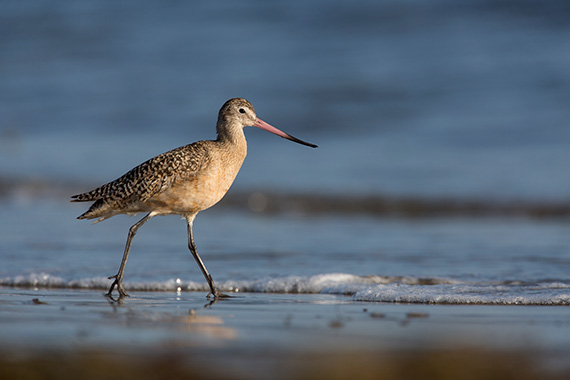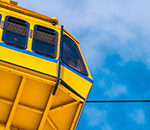Instantly improve your photos of birds in the wild with these eight tips. Then, learn everything you need to know to capture the beauty and grace of birds in the wild, from lighting and gear to reading bird behavior. Join esteemed biologist and expert bird photographer Neil Losin in the online Craftsy class Photographing Birds in the Wild.

Marbled Godwit
1. They say patience is a virtue
When photographing birds, you don’t have a lot of control over lighting or positioning. Once you find the bird you want to photograph you have to be patient and stay ready to get the shot. Getting impatient and trying to corral a wild bird will not help you to get a great shot.
2. Make use of your continuous shooting mode
Many birds can move quickly and change directions quickly while in flight—quicker than it takes our brains to tell our fingers to press the shutter. To avoid missing a magical moment, use the continuous shooting mode to capture a rapid succession of images. This allows you to pick the best image out of a series.

Use continuous shooting mode to capture the best moments.
3. Use a long lens and/or teleconverter
For most birds, you need to be far enough away that you don’t scare them off. This requires a long lens. Ideally, we all would have access to an 800mm lens to give us some distance from our subjects while allowing us to capture the amazing detail in feathers. If you aren’t so lucky, grab the longest lens you have and shoot from as close as the bird will let you get. Consider using a teleconverter to extend the length of your lens, typically at a fraction of the cost of a whole new lens.

Use a long lens to capture detail without disturbing the bird.
4. Use a fast shutter speed
Since birds move quickly in flight your shutter speed needs to be fast enough to freeze the motion. This is similar to sports photography. Think 1/1000 of a second or faster. The longer the lens and the further away the bird is, the faster your shutter speed needs to be to keep the bird in focus.

Fast shutter speeds freeze a bird’s action.
5. It’s OK to shoot in direct sunlight
When shooting portraits of humans, we tend to avoid shooting in direct sunlight because of the harsh shadows that are created on the face. With birds, the effect is not the same and many times they look better in direct sunlight because of the way some species’ feathers reflect light.

Some birds look best when photographed in direct sunlight.
6. Know something about the birds you are shooting
Like any photography subject, having some knowledge is helpful. If you know some basic facts about the bird you would like to photograph—where it lives, when it eats, when it is most active — you may come up with some better photos and spend less of your time waiting around.

Learn about the birds you want to photograph.
7. Be sensitive
Birds generally have great eyesight and can see you coming before you see them. Many birds in the wild spook easily, so it’s important to not make any sudden movements or loud noises. Also, as with most wild animals, staring them in the eye is perceived as a threat and can cause them to fly away.

Be sensitive to wildlife.
8. Focus on the eye
If at all possible, focus on one of the eyes. Just like photography of human subjects, the viewer is drawn to the eyes. Having eyes in focus makes for a stronger image.

Focus on the bird’s eye.
Now that you have a few tricks up your sleeve, take the next step towards spectacular bird photography when you sign up for the online Craftsy class Photographing Birds in the Wild. Eight video lessons you can watch anytime, anywhere as you master lighting, focus and composition. Also personalized advice and your photos critiqued by expert Neil Losin.
What do you find to be most helpful to keep in mind when photographing birds?
Like This Article?
Don't Miss The Next One!
Join over 100,000 photographers of all experience levels who receive our free photography tips and articles to stay current:





Thanks for the great simple, clear article. I’ll have to look into a teleconverter rather than getting a new lens potentially. Do you know if you still get good quality as a telephoto lens or not quite?
Nice and short to the point article, I specially like the be sensitive and know something about the bird you want to photograph – these are the skills required as one does not alarm the bird while photographing them in their habitat, and most important one is not to break branches to get a clear view, one should understand that we have intruded in their space and therefore respect for their space is utmost important.